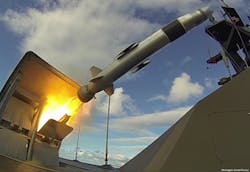Raytheon to build land-attack missile with imaging infrared seeker and fire control for new Navy frigate
WASHINGTON – Surface warfare experts at Raytheon Technologies Corp. are continuing their work to develop the U.S. Navy's next-generation anti-ship and land-attack missile for the littoral combat ship and FFG(X) future multimission guided-missile frigate.
Officials of the Naval Sea Systems Command in Washington announced a $102.7 million order Tuesday to the Raytheon Missiles & Defense segment in Tucson, Ariz., for the Over-the-Horizon Weapon System (OTH-WS).
Raytheon engineers will build and deliver OTH-WS encanistered missiles loaded into launching mechanisms and a fire-control suite. Raytheon won a potential $847.6 million contract in June 2018 for the OTH-WS project.
Raytheon is building the new missile in partnership with Kongsberg Gruppen in Kongsberg, Norway. The missile is to equip the littoral combat ship and FFG(X) future frigate with stand-off surface-to-surface weapons capability.
Raytheon and Kongsberg in their initial OTH-WS bid offered the Naval Strike Missile (NSM) -- a fifth-generation long-range, precision-strike missile that offers strike capability against heavily defended land and sea targets. NSM is a modernized version of the Norwegian Penguin anti-ship missile.
The passive subsonic sea-skimming missile can penetrate advanced enemy defense systems, and has an upgraded seeker and target identification, Raytheon officials say. The NSM is aboard Norway's new frigate and coastal corvette, and gives surface warships sufficient firepower to defeat evolving threats.
The NSM uses composite materials for enhanced stealth, and a titanium-alloy blast-and-fragmentation warhead with void-sensing programmable intelligent multi-purpose fuze for use against hard targets like surface ships.
The missile has an imaging infrared seeker, an onboard target database, and navigates by Global Positioning System (GPS), inertial sensors, and terrain-reference systems. It can detect, recognize, and discriminate among targets independently, and is designed to strike enemy ships at or near the water line to inflict maximum structural damage.
Aboard ships, NSMs can be deck-mounted in packs of one, two, three, four, or six launchers. The NSM weighs about 880 pounds and has a range of about 100 nautical miles. It can be used in littoral waters near coasts, or in the open ocean. The missile can fly over and around land masses, travel in sea-skim mode, and then make random maneuvers in terminal phase to avoid enemy countermeasures.
Raytheon will build a NSM fire-control suite with operator interface, interfaces to the launchers, engagement planning system, and interface to host ship systems like GPS and inertial navigation systems. Its fire-control system will be able to launch from four to 16 missiles.
On this order Raytheon and Kongsberg will do the work in Kongsberg and Raufoss, Norway; Tucson, Ariz.; Schrobenhausen, Germany; McKinney, Texas; and Louisville, Ky., and should be finished by May 2024. For more information contact Raytheon Missiles & Defense online at www.raytheonmissilesanddefense.com, or Naval Sea Systems Command at www.navsea.navy.mil.

John Keller | Editor-in-Chief
John Keller is the Editor-in-Chief, Military & Aerospace Electronics Magazine--provides extensive coverage and analysis of enabling electronics and optoelectronic technologies in military, space and commercial aviation applications. John has been a member of the Military & Aerospace Electronics staff since 1989 and chief editor since 1995.

